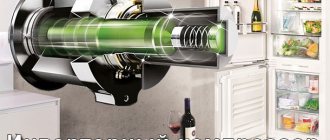There is a freshness zone in the latest generation of refrigerators, although they began to introduce it quite a long time ago. From our review you will learn how refrigerators with a freshness zone differ from models without it. We'll tell you what it is, how the technology works and where it can be found.
What benefits does it provide to the consumer?
There are usually no problems with frozen meat. Even if you buy a large piece worth several kilograms, it will not go to waste. Some can be prepared immediately, some can be put in the freezer, where it will safely last for 3-4 months. But what to do with chilled meat? You can’t buy a lot of it, it will spoil, it’s not always possible to buy little by little, and you also want to run to the store every other day for a piece of 200 grams. will disappear quickly. In this case, the freshness zone will help out.
According to manufacturers, the shelf life of products in this compartment increases several times due to the low temperature. You can put perishable foods, chilled minced meat, fish, and lettuce in it to cook them in a couple of days.
Budget models have one freshness zone for all types of products. More expensive ones can have two installed: one for vegetables and herbs, the other for meat products. They differ in humidity. In the compartment for meat products, sausages and cheeses, it is maintained at about 50-55%. Greens, vegetables, berries and fruits, on the contrary, require high humidity to maintain their freshness. There are models in which both zones are combined in one compartment. This is achieved simply by installing a plug. The plug is closed - air does not circulate, humidity remains high. The plug is open - the air is constantly renewed and the humidity decreases.
This is interesting: Why can’t you put hot food in the refrigerator - what will happen?
Dry and wet freshness zones and their differences
To prolong the freshness of various products, not only a stable zero temperature is required, but also appropriate humidity. Therefore, the fresh zone can be dry and wet.
- A dry fresh zone is one where the humidity is maintained at 50% and the temperature is 0 °C. It is suitable for storing meat and fish products, sausages, cheeses, and semi-finished products.
- The wet fresh zone is characterized by high humidity – up to 90% and a temperature from 0 to 3 °C. It is intended for storing berries, fruits, mushrooms, vegetables and herbs. And if in a regular vegetable compartment greens and vegetables begin to wither on the third day, then in the zero zone they are stored for up to two weeks.
Expensive refrigerator models have both zones, while budget models have one of the two. Some brands combine dry and wet parts: the humidity is regulated using a damper, opening which gives increased humidity, and closing it results in a dry zone.
Who needs this and why?
Of course, it’s already cold in the refrigerator. However, even in the simplest refrigerator, the temperature is distributed unevenly; each shelf has its own specific purpose. The compartments located on the door are considered the warmest.
The freshness zone is a compartment where the temperature is close to zero. There may be:
- fresh meat and fish, minced meat;
- sausages and cheeses;
- fresh cottage cheese;
- vegetables and fruits, mushrooms;
- leafy vegetables and greens.
Many will say that all these products fit quite well on regular refrigerator shelves. A fresh zone is necessary if:
- You follow the principles of healthy eating. Without perfectly fresh products it is impossible to create a healthy breakfast/lunch/dinner.
- There is a baby in the house for whom the mother prepares complementary feeding dishes (or simply prepares him separately according to the children's menu).
- You like to buy dairy products (sour cream, cottage cheese, cheese) in bulk at the market. They taste, of course, superior to products in factory packaging, but their shelf life is very short, and bacteria multiply in them very quickly.
- Do you like to make cottage cheese/kefir/yogurt yourself (using starter cultures). It is also extremely difficult to maintain sterility here.
- You purchase fresh meat or minced meat in large portions for future use. Of course, the bulk of what you buy will go into the freezer, but portions for the next 1-2 days can be left in the freshness zone to enjoy the taste of dishes made from truly fresh meat. The same applies to fish.
- You actively use the freezer and often defrost food for further cooking. In the freshness zone, food thaws perfectly (slowly and without damage).
- You collect berries and mushrooms in the forest or in the garden for food and further preservation. They lie very poorly, but require a lot of fiddling. While some mushrooms are soaked and cleaned, others can lie quietly at zero temperature.
How do products last longer in the freshness zone?
Expert opinion
Smirnova Ekaterina Anatolevna
7 years of experience in interior design, professional architect
Saved, fact. And you don’t need to listen to skeptics and home-grown gurus who chuckle: “They came up with this... What other zone of freshness is there? And then what about the rest? Stale zone?
In this compartment the temperature is maintained at 0C, whereas in a regular refrigerator compartment the cooling range is from +4 to +7, and in the freezer there are already sub-zero temperatures.
The freshness zone can be compared in functionality to a butcher shop window; it has the same degree of cooling. It allows you to keep food fresh, preventing decomposition and the development of bacteria, without freezing a bit.
If the degree is a little higher or lower, a similar result will not come out, no way. There is also an opinion that there is no need for a freshness zone. They say, set the overall temperature to about +1 - + 2 and you will get a freshness zone without overpaying, and, moreover, not just one drawer, but the entire refrigerator.
So, this is nonsense. If you do this, the refrigerator will “live for a long time.” Well, it is not designed to constantly work at too low temperatures. There is an optimal “fork” for it – +5 -+6 degrees, and all other functions are calculated from this: auto defrost, power consumption, motor depreciation...
Therefore, of course, it costs you nothing to “save” in this way. Only, very soon you will need to buy another refrigerator. So calculate how much you will save in the end.
See also:
Features of different manufacturers
Unfortunately, there is no uniform standard for designating the freshness zone or zero zones in refrigerators. Therefore, each manufacturer comes up with its own names, trying to impress customers.
Manufacturers Liebherr, who pioneered the freshness zone in refrigerators, call it BioFresh. Modern models provide the ability to regulate the humidity level in the freshness zone, depending on what products you intend to store in it.
The zone itself is divided into two compartments, in each of which you can set the DrySafe (dry cold) and HydroSafe (wet cold) mode.
Expert opinion
Smirnova Ekaterina Anatolevna
7 years of experience in interior design, professional architect
But the freshness zone in the LG refrigerator is called Vita Fresh. It consists of two retractable compartments, with mode regulators. All you have to do is select the desired mode, for example, “vegetables” or “meat”.
For other manufacturers, the freshness zone may be called Flex Cool Box, Food Care Zone, Fresh Box, Fresh Zone, etc.
Adviсe
Any complex technique requires careful handling. Before starting operation, you must study the instructions and carry out regular maintenance according to the recommendations - this will significantly increase the service life of the refrigerator.
It is recommended to clean the zero zone 1-2 times a month.
If an unpleasant odor appears in the freshness zone, and it is not possible to determine the cause, and cleaning does not remove it, just place a handful of activated carbon in the chamber, and the smell will disappear in a day.
If you notice frost or a thin crust of ice on the products, do not be alarmed, this is a feature of the model. Freezing will not go deeper and will not affect the quality and shelf life.
See also: What should be the temperature in the refrigerator, how to determine it, how to set it, a table of temperature conditions for some products.
On practice
When purchasing a refrigerator, you can immediately understand whether it has a freshness zone. Manufacturers usually include this technology right in the name. “ Fresh Box”, “Natura Fresh”, “BioFresh”, “Vita Fresh”, “Flex Cool”, “Zero-N-Fresh” - these are all the names of zero compartments from different developers.
The freshness zone is a shelf, compartment or container. It can be retractable, or it can be hidden behind a folding panel. In inexpensive refrigerators, there is usually only one freshness zone. More expensive models often have two compartments that serve different purposes. One is for meat and dairy products, and the other is for vegetables and fruits. They differ in the level of humidity: the “meat” zone is drier, the “vegetable” zone is moist. There are models where the humidity in the compartments can be adjusted independently.
To prevent food from having a thin icy crust, experts recommend wrapping everything stored in freshness zones tightly with cling film.
Sometimes manufacturers use a trick and simply call the lowest compartment in inexpensive refrigerators the freshness zone. You don’t need to have encyclopedic knowledge to understand that cold air concentrates below, and warm air rises. Accordingly, the manufacturer calls the coldest place the freshness zone. However, a constant temperature in such a compartment is not maintained. Accordingly, if for some reason the refrigerator becomes even a degree warmer, all the “freshness” will quickly disappear. If it gets cold, this compartment will instantly become a branch of the freezer.
Such a chamber is usually located in the center if the refrigerator has three chambers, or closer to the freezer (at the top or bottom) if the refrigerator has two chambers.
It is important to understand how the freshness zone is cooled, because the quality of its work depends on this. In refrigerators AEG, Gaggenau, Leibherr (by the way, this brand was the founder of all technology) the air cooling system is autonomous and is in no way connected with other parts of the refrigerator. This may be its own cooling element, which is controlled by a thermostat. There are models of refrigerated cabinets where you can set the temperature inside the freshness zone yourself.
For budget models (for example, Indesit or Siemens), the temperature inside the zero zone is maintained due to its proximity to the freezer.
Cooled air enters there from the freezer compartment through a special tube. This option is not the best, because the temperature cannot be kept at the same level all the time.
Those who seek to support the domestic manufacturer need to know that there are no Russian refrigerators with an adequate freshness zone on sale. The Belarusian Atlant produces several models, offering the simplest technology.
Appearance
Externally, the fresh chamber may look different. In some versions, this is a separate compartment with a tight-fitting lid; in others, there is a separate part with its own outer door, that is, a three-chamber refrigerator. This block cannot be separated from the entire unit; it cannot be removed.
In inexpensive refrigerators, the fresh box is located next to the freezing compartment and is cooled from it. Cold air enters inside through a special channel. Conditions from -3°C to +3°C are maintained here.
In expensive brands, zero zones are made with their own cooling system. They have sensors that monitor and regulate the temperature inside and fans to equalize it. In this case, the characteristics include the name “zero chamber”, there is a separate door and the ability to set parameters as desired.
In cheaper devices, there is only one zero zone with a humidity of 55%. In expensive models there may be two (dry and wet). Sometimes there are three. One is dry for meat and fish, one is 95% moisture for greens, and the third is 55% moisture for fruits and vegetables that contain a lot of water.
How to understand that sellers are substituting concepts?
Perhaps the opinion of skeptics is based precisely on the fact that they had to face a pseudo-zone of freshness. Yes, there is such a thing.
Taking advantage of the fact that this is a popular innovation, some stores shamelessly call ordinary vegetable storage boxes, which are usually located below, closer to the freezer, a freshness zone. And due to the fact that the drawers are more or less closed and are located in the coldest part of the unit, vegetables are stored there better than in the upper compartments.
But this has nothing to do with the real freshness zone! And put a piece of meat there, it will disappear just as quickly as in other places in the refrigerator. Even faster, due to the fact that there is poor air access, but not a vacuum at all.
So, how can you determine that the seller is being dishonest by calling the freshness zone something that is not what is needed? However, it may be that he himself doesn’t really know. Therefore, as they say: trust, but verify!
But, besides this, you should know exactly what a real refrigerator with a freshness zone looks like.
- It is never removable
- Separate outputs are visible on the back wall
- In some models, the temperature is regulated in it
- It looks like a tightly closed box
- Located, as a rule, in the middle of the refrigerator
That is, you must understand that this section does not depend on the temperature of the refrigerator itself and there are separate openings for it to supply cold air.
This is interesting: Calculation of energy savings when using LED lamps
Advantages and disadvantages of the fresh zone
Let's look at the positive and negative aspects of the freshness zone in the refrigerator.
Advantages
Having such a zone makes cooking easier. It is convenient to immediately put already chopped meat or fish into a saucepan or frying pan. If you choose this option, then:
- it will be possible to store food supplies in the best conditions;
- food costs will decrease as food is stored longer;
- savings arise due to reduced food waste;
- there is a guarantee of the freshness of the products reaching the table;
- the penetration of foreign odors from one compartment to another is eliminated, since they are reliably isolated from each other.
Flaws
The high price is the main disadvantage of the freshness zone, but the only one. By the number on the price tag you can guess whether a given model has a freshness zone or not. The cost of refrigerators that have it is at least a third higher than the rest. The most expensive ones will be those in which the fresh box is separated into a separate block.
Refrigerators with a freshness zone are not only more expensive, but also require more careful handling. Their repairs can only be carried out by qualified technicians.
Direct purpose of the freshness zone
The fresh zone in the refrigerator was developed by the German company LIEBHERRS in 1996. Having gained popularity, this system is now provided in refrigerators of different brands, only it is called differently: Biofresh, Miracle Zone, Fresh Converter, Opti-Temp Zone, Fresh Box, Natura Fresh, Food care zone, Chilled room, zero chamber/zone.
As a standard, one third or fourth of the refrigerator is allocated for it, where a certain temperature is always maintained. It looks like a tightly closing shelf or box, most often located in the upper part of the refrigerator compartment, but there are models with a lower freshness zone.
Why do you need Fresh zone in the refrigerator:
- There are categories of products that require a temperature of 0 to +2 °C for preservation. When frozen, fish and meat lose some qualities: frozen water destroys their structure and they spoil faster. Cheese, sausage, and vegetables quickly lose their freshness in the common compartment, but here their shelf life will be extended.
- The fresh zone is in demand among families with small children, since the chilled room in the refrigerator will provide the optimal temperature for baby food.
- It is convenient to store homemade dairy products here, because the development of bacteria in them will be stopped due to the zero temperature.
- For those who are on a diet, the Food care zone will be of help - fresh salads, herbs, and pre-cut vegetables will always be at hand throughout the day.
The zero chamber in the refrigerator helps to preserve food longer than usual due to the fact that the temperature is always maintained here close to zero. This prevents the development of bacteria and microbes, extends the shelf life of products, and preserves their taste and benefits.
The fresh zone can be a separate compartment in the refrigerator, along with the freezer and the main chamber. Refrigeration units of this type are much more expensive.
What is the difference between the freshness preservation zone and the main chamber?
The fresh zone is an isolated place where the temperature is low and the humidity, on the contrary, is high. It may look like a pull-out shelf with a door or a tightly closed box. On the back wall, where the zero zone is located, there is a temperature regulator, and in budget options there is a slot through which cold air is supplied from the freezer.
Thus, food supplies here are stored 2-3 times longer than on regular shelves inside the refrigerator.
When purchasing a refrigerator, carefully examine it from the inside. The instructions for cheap models may claim a Fresh zone function, but it may turn out to be an ordinary transparent box in the refrigerator, disguised as a fresh zone. It is easy to identify such a trick: if the box can move inside the refrigerator and be installed in any place, then it is not a Fresh zone.
Important: The freshness zone compartment has its own place in the refrigerator; it cannot be replaced by another shelf or moved inside.
How is zero temperature maintained in the freshness zone?
The zero temperature level depends directly on the refrigerator model. If the Fresh zone is in the lower part (budget models), then zero temperature occurs according to the law of physics: warm air rises up and cold air goes down.
In the upper compartment, the temperature is maintained by cold air from the freezer, where special outlets are provided for this. There can be no precision here, so there will be fluctuations between 0 and 2 °C.
Expensive models have special temperature and humidity controllers that provide accuracy in degrees. You can set the temperature manually or, if it is an electronic system, using the remote control.
Where is it located and how does it work
In cheap models, the zero compartment of the refrigerator looks like a container located near the freezer. In higher quality devices, the fresh zone is located independently of the main compartments. On some models, all compartments can be switched to zero mode. Let's look at where the freshness zone is in the refrigerator, what it includes and how it works:
- In cheap devices, temperature reduction is ensured by proximity to the freezer. Additional structural elements are not used.
- In more expensive models, cooling is provided by a constant flow of cold air from the freezer.
- In premium devices, the freshness zone has a separate evaporator with a built-in fan that distributes air flow. The temperature in the zero compartment can be adjusted.
Types of boxes
Each type of product has its own requirements for moisture levels and temperatures. The wet fresh zone maintains humidity parameters at 95%. Vegetables, fruits and herbs are kept in a chamber at 0-+3C for 1-1.5 weeks. Under normal conditions, capricious food will turn yellow by the 3rd day, and will rot by the 4th day.
Dense root vegetables retain their quality for 3 months. Low degrees do not allow carrots or potatoes to germinate. In a humid zone of freshness, a greenish tomato will not only ripen, but also preserve its aroma. In pears and apples, the pulp remains strong and juicy. Cucumbers, zucchini and pumpkin do not lose their taste characteristics.
Moist freshness zone Source ikuhnya.com
A dry fresh zone is a compartment in which the humidity level is maintained within 50%. The box has a constant temperature from -1 to 0C. In such a microclimate you can keep raw fish, meat and minced meat for 72 hours. In a regular refrigerator compartment, the very next day sticky mucus will appear on the surface of the food.
If you put food in a dry freshness zone, the shelf life will double. The chamber volume is often larger than that of the high humidity model. Dimensions ensure uniform distribution of air and low temperature. The cold may cause a thin layer of frost to appear on the food, but without deep freezing. Frost does not affect the taste.
Dry freshness zone Source severdv.ru
In modern units, the freshness zone is divided into several chambers with different temperature and humidity levels. Expensive refrigerators use 3 sections, located one above the other. The bottom one holds long-life products, a little higher is a low-humidity box, and the top one holds plant foods. Sometimes a damper is placed between the parts, with which the owner adjusts the parameters.
What other names are there?
The name of the compartment may vary significantly depending on the brand. If you ask a consultant when buying a refrigerator whether it has Biofresh, he may say that there is no such option. Just the name of a similar function will be different.
It’s not for nothing that manufacturers call their developments differently, since they use various unique technologies in them. So you may come across:
- Biofresh - at Liebherr;
- Fresh Zone, Opti-Temp Zone, Miracle Zone, Fresh Converter (for meat and vegetables), Fresh Balancer or Opti Fresh Zone - in LG and AEG;
- Fresh Box - at Hotpoint Ariston;
- Natura Fresh - in Electrolux;
- Flex Cool - in Indesit;
- Vita Fresh - at Siemens and Bosch;
- Zero'N'Fresh - in Gorenje;
- Cool Select Zone - in Samsung and others.
The technical specifications indicate the presence or absence of a “freshness zone” or “freshness box,” so you can’t go wrong. But keep in mind that up to 20% of refrigerators do not provide such a shelf. You will also not find a zero shelf in Russian or Belarusian devices (Atlant, Stinol), as well as in budget imported models.
What do popular equipment manufacturers call the freshness zone?
Freshness zones are called differently for each brand. Firstly, our market is mostly a foreign manufacturer and the translation of the name is not entirely accurate. And secondly, they apparently deliberately invent unique names for better memorability.
So, what do different companies call this function?
- Liebherr – Biofresh
- AEG and LG – Fresh Zone
- Hotpoint Ariston – Fresh Box
- Electrolux – Natura Fresh
- Indesit – Flex Cool
- Siemens -Vita Fresh
- Gorenje – Zero'N'Fresh
Domestic manufacturers have almost no products with this function.
How does it work
In Economy class models, the zero compartment is designed as a separate box - in it, products are cooled solely due to the proximity of the box to the low-temperature zone, so additional parts are not used to regulate the temperature in the compartment. These low-cost technologies are most often found in Indesit technology. In Siemens, the compartment is cooled due to the intake of cooled air flows coming from the freezer - for this, the manufacturers laid a separate channel in the “fresh” zone.
Engineers from AEG, Gaggenau, Siemens, and Liebherr have created a more complex technology. The freshness zone has its own evaporator and does not depend on the cooling systems of the other chambers. It sometimes has a built-in fan that distributes air flow. Also, the “zero” compartment in the equipment of these brands is often adjustable, since the design has a temperature sensor. It monitors the indicators and controls the evaporator to ensure that the temperature values stay within the set limits. In LG devices with Miracle Zone, you can control temperature marks from the remote control.
Principle of operation
The temperature in the refrigerator is distributed unevenly, so each shelf has its own parameters and purpose. In the conditions of the cooling chamber, it is impossible to store quickly perishable products for a long time. When freezing meat, vegetables and fruits, the structure is destroyed, which leads to a loss of nutritional value.
The freshness preservation zone is a special chamber in which a favorable microclimate is created for all types of food. The compartment is maintained at a constant temperature ranging from -1 to +1, although more often it is zero degrees. The first refrigerator model with this function was released by the Liebherr brand, and units are now offered by other manufacturers.
Products with a limited shelf life are placed in the freshness zone. The design provides:
- Low temperature. The temperature is higher than in the freezer and lower than in the main chamber. Under such conditions, fish and meat retain their quality for 3 days without freezing.
- High humidity. In the freshness zone, vegetables, fruits and berries retain their natural elasticity, and greens do not wither.
- Stops destruction. You can keep sensitive foods in the compartment before preparing (preserving). Food retains its original quality for several days.
No. 4. Freezer
The optimal temperature for the freezer is considered to be -180C , but if you are not going to store anything more than a couple of packages of ice cream there, i.e. the chamber will remain almost empty, then you can set the temperature to -140C. If the camera is heavily loaded, then it is better to choose the -20...-240C mode.
As a rule, the range of possible temperatures in the freezer ranges from -6...-240C and is indicated by dashes, snowflakes, stars, marks, etc. Typically, each division is 60C . There are models where the freezer can maintain a temperature of -300C, but in everyday life such an extreme is rarely needed. This function is called “Extra-freezing”, “Quick freezing” or something like that, it may be needed if you need to freeze something in record time to preserve the maximum amount of vitamins.











